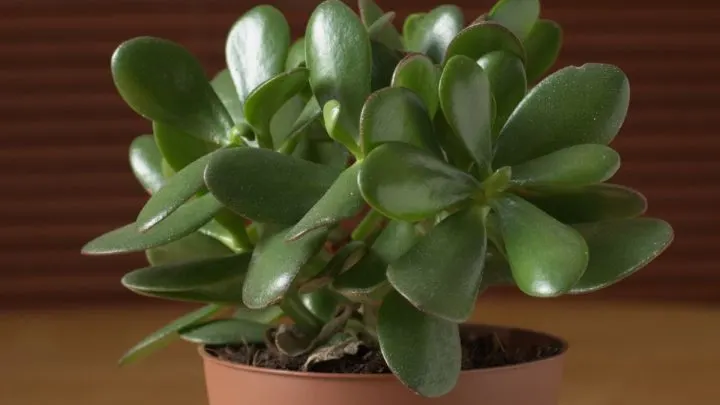In today’s article, we will talk about types of jade plants. I am sure that your grandmother or mother had it at least once in the apartment or house.
These plants date back far into the past and form the decor of many homes, both those where the elderly live and the homes of the younger ones.
Its beautiful variations will beautify your home in seconds. Green, golden, greyish silver, white, pink leaves, the choice is yours, and in truth there are many!
This is one of the plants that offer so many different types in its family that you won’t want to look for any other plant when you see all its species.
If you have been missing color and beautiful fat leaves in your home lately, let’s learn all about the types of jade plants then.
Top 9 Types Of Jade Plants!
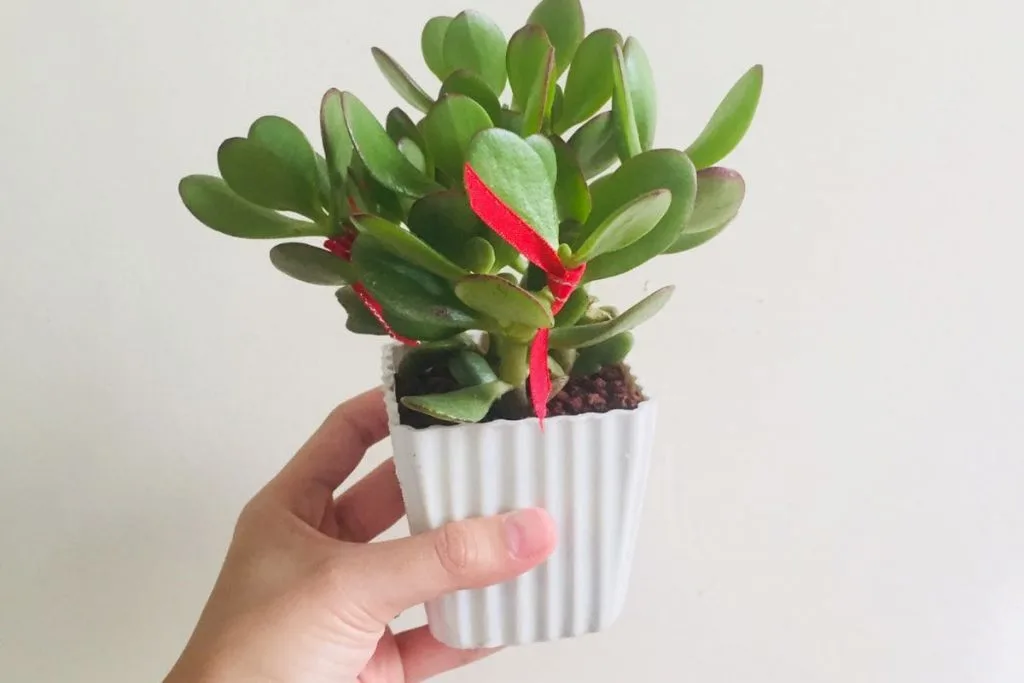
One of the loveliest fast-growing house plants doesn’t have a hard care guide at all. Once you learn simple tricks on how to take care of it, you’ll be more than proud and happy to grow such a plant in your home.
All of these varieties have a very similar care guide so, once you learn all about 1 care guide, you’ll be able to take care of almost 90% of these plants.
Types of jade plants aren’t complicated and you’ll learn that below. If you’re ready, let’s learn the care guides for jade plants.
1. Dwarf Jade Plant – Portulacaria Afra
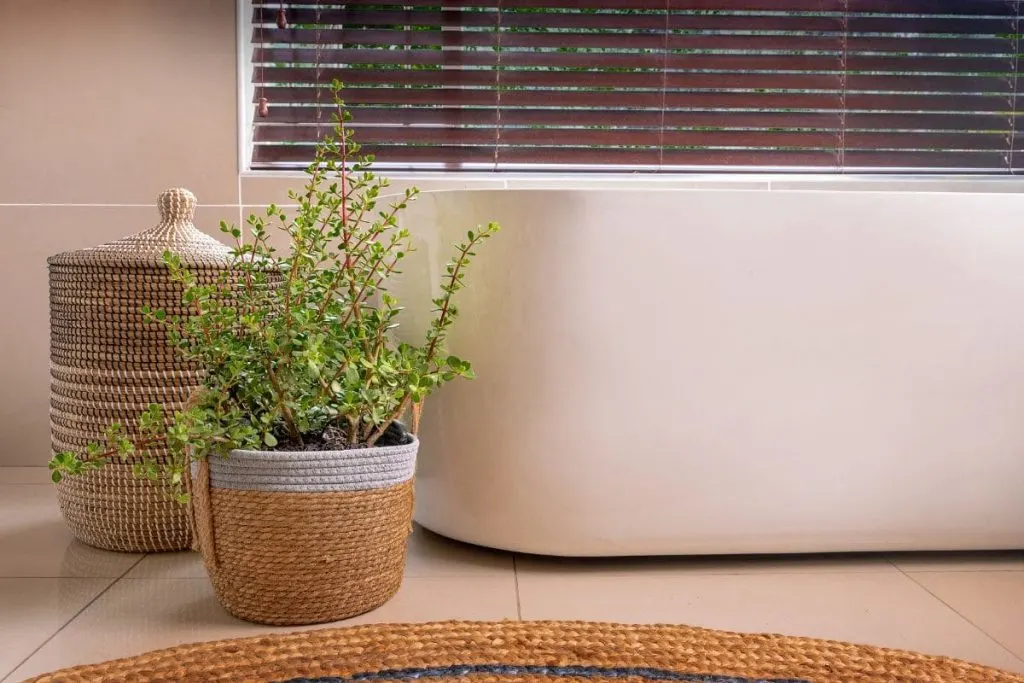
The adorable round fat leaves will complement any home. The plant grows quite low, does not spread much, and it will be easy for you to place it anywhere.
It has beautiful little leaves that are not demanding at all, and with the little care you give them, you will be grateful and happy later. It’s a famous plant with red stems.
LIGHT NEEDS
Jade green leaves need bright indirect light and the most suitable position for this plant is an east-facing window when there’s much direct morning sun and south facing window for the afternoon hours when there is bright light. Constant direct sun can easily damage your jade dwarf plant.
WATER SCHEDULE
This lovely type of jade plant doesn’t need much water to thrive healthily. They’ll appreciate it the most if you water them once in 8-10 days. They prefer tap water, but basically, any water type is also fine.
SOIL TYPE
If you want to give the best conditions for your jade plant, provide them with a cactus potting mix. They grow best in such soil conditions. They don’t like soggy or acidic soils at all.
FERTILIZER
You can use a regular houseplant fertilizer for the jade plant. Fertilize your dwarf jade plant in early spring or late winter time before their growing season begins.
TEMPERATURE AND HUMIDITY
They grow best in temperature conditions between 60 and 70F. Their roots can easily freeze in low temperatures and sudden temperature changes can cause brown edges issues. The best humidity levels for these plants are medium, 50 to a maximum of 60%.
PROPAGATION
Some people place stem cutting in water, but this is a harder way. A much quicker way is to place regular stem cutting in the pot or to do a seed propagation.
2. Pink Jade Plant – Crassula Ovata Pink Beauty
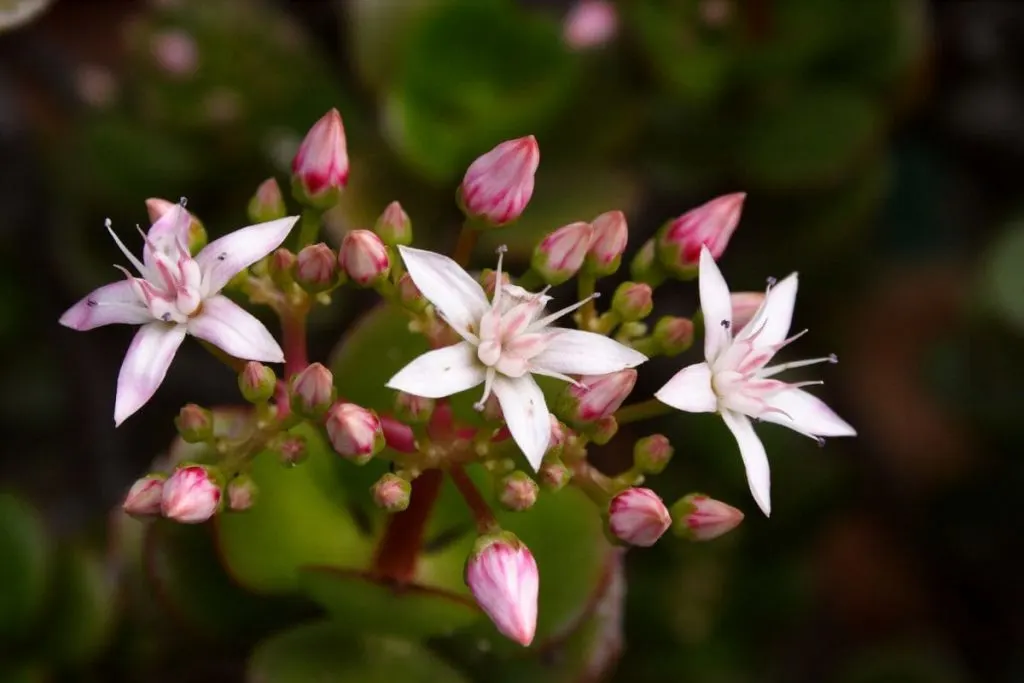
What is more excellent than pink flowers in your home? Pink flowers on oily green leaves, you’ll fall in love with this plant immediately! They are native to Northern America, but they can grow in warmer conditions as well.
LIGHT NEEDS
The pink jade plant should get at least 4 hours of direct sunlight. It’s more than important to provide your plant with these sunlight hours or in that case, it won’t thrive so well. Shade isn’t the recommendable option for pink jade.
WATER SCHEDULE
They don’t need much water. You can water them once in 10 days and of course, you can always do a finger check to make sure they need water before 10 days or you can go up to 12 or 13 days. It’s good to make sure your pot has drainage holes.
SOIL TYPE
Clay soil, loamy soils, and regular house potting mix are good types of soils for pink jade. It doesn’t like sandy or soggy soils.
FERTILIZER
You can use the same regular houseplant fertilizer for this jade plant as for the dwarf jade plant. Fertilize them in early springtime.
TEMPERATURE AND HUMIDITY
The best temperature conditions for pink jade plants are between 55 and 65 F. Lower temperatures are also fine as long as they’re not exposed to low temperatures for too much time. Humidity levels should be around 60%. If your room doesn’t have 60% humidity, get an air humidifier.
PROPAGATION
Propagate jade pink plant with stem cuttings from a healthy cut-off stem and with seedlings. Always use a sharp knife when cutting stems off to avoid any damage.
3. Golden Jade Tree – Crassula Ovata Aureum
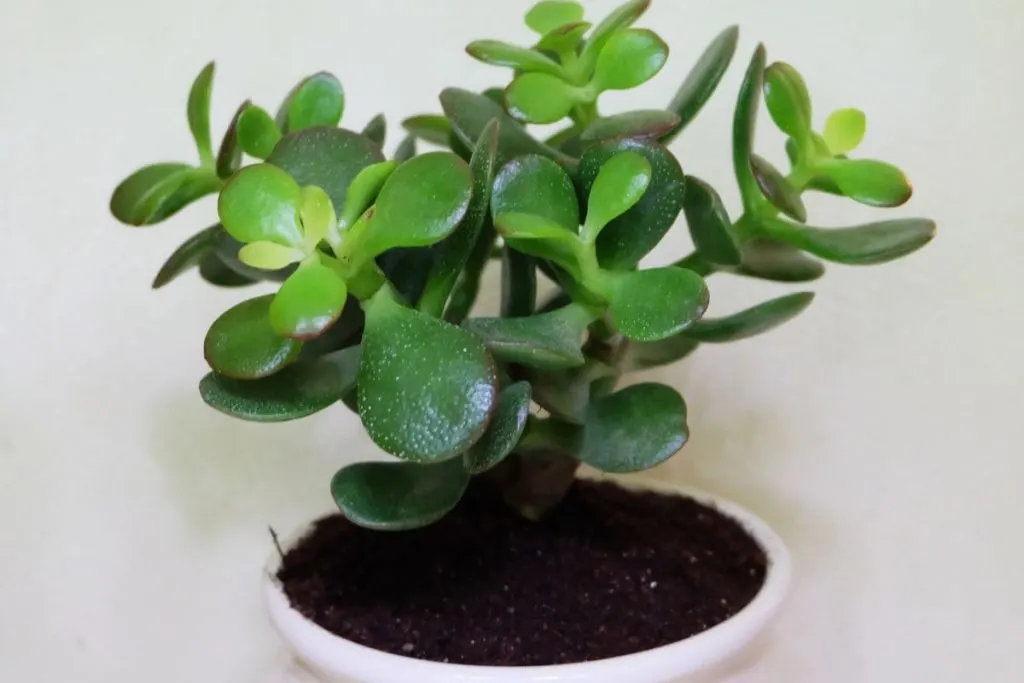
The golden jade tree is very similar to the bonsai jade tree. Once you do its pruning, you’ll see how easily you can achieve this plant to look like a bonsai tree. The only difference is its flowers/leaves that are not exactly like the ones on bonsai trees of course.
LIGHT NEEDS
Light green leaves with a dash of yellow color and red edges need partial shade, two hours of direct sun, most likely in the morning hours, and bright indirect light in the afternoon. Evening and night will provide them with needed shade.
WATER SCHEDULE
You can water this plant twice in 10 days, but make sure you always do a finger check and of course, make proper drainage holes at the very start.
SOIL TYPE
Crassula ovata likes clay soils and cactus potting mix the most. They don’t do well in loamy, soggy, or sandy soils. Well-drained soils work well too. Soils should be slightly acidic, pH of 5.5-6.
FERTILIZER
Fertilize them in the early springtime or late springtime with balanced liquid fertilizer. Nitrogen-high fertilizers don’t work well for these jade plants.
TEMPERATURE AND HUMIDITY
Temperatures should be between 50 and 65 F. Avoid sudden temperature changes. Humidity levels can be between 40 and 50%.
PROPAGATION
Use the same way of propagation as the 2 types of jade plants above-stem cuttings and from seedlings. You can try water propagation for this type of jade plant as well, but it takes much time and patience. Always use freshly bought soil when propagating.
4. Jade Necklace Tree – Crassula Rupestris
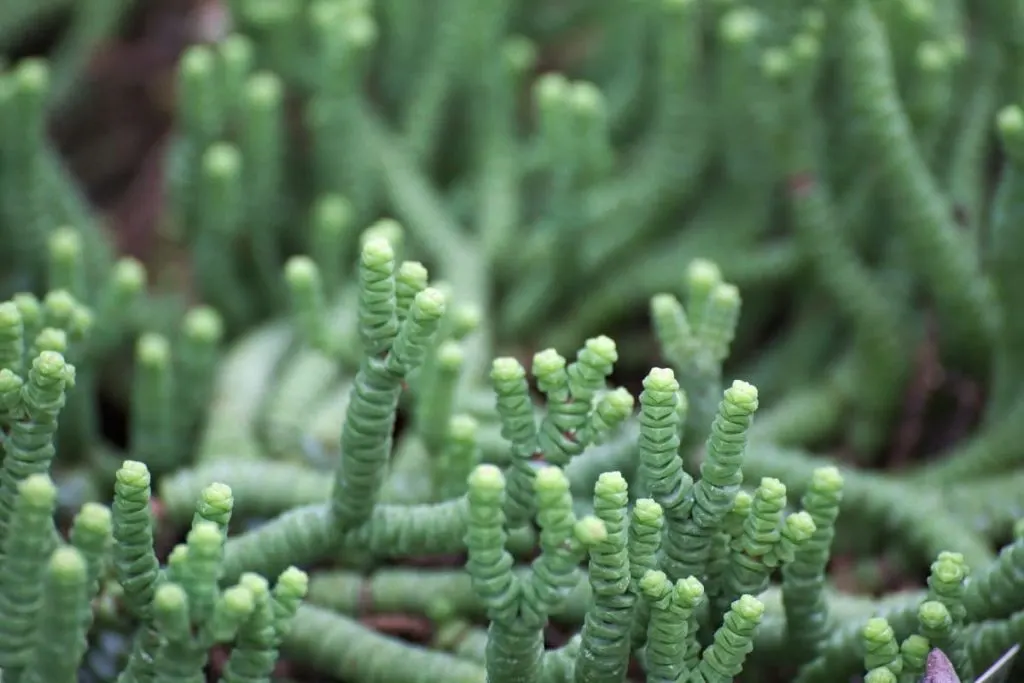
The Jade necklace tree is a small deciduous tree that is most definitely one of the most unique types of jade plants. It is very similar to red twist peperomia in its size and shape. They grow almost the same way in the pot indoors.
LIGHT NEEDS
The Jade necklace tree prefers bright indirect light and partial shade in the afternoon hours, the best location for this variety of jade plants is a west-facing window.
WATER SCHEDULE
Water it regularly 3 times in 15 days. But always, as we mentioned above many times, do a finger check. Some people avoid this and it easily leads to root rot issues. Standing water is a bad thing for houseplants.
SOIL TYPE
This jade type isn’t very picky with its soil types, but sandy soil for example just doesn’t suit it well, so, avoid that one and try the other ones (clay, loamy, perlite, peat moss).
FERTILIZER
Fertilize it in March or April with liquid fertilizer. they can be fertilized 2 times per year. In early springtime and late autumn time as well. Do not fertilize it in the wintertime.
TEMPERATURE AND HUMIDITY
Don’t expose it to temperatures below 50 F and higher than 70 F. Humidity levels can be from 40 to 60%. When you’re having a lack of humidity issues, make sure you buy an air humidifier. This isn’t recommendable for a bedroom.
PROPAGATION
Propagate it with stem cuttings by cutting off the healthy stem from the parent plant and placing it in fresh well-drained soil. In about two weeks, you’ll notice progress. Fresh soil can be fertilized as well.
5. Silver Dollar Jade – Crassula Arborescens
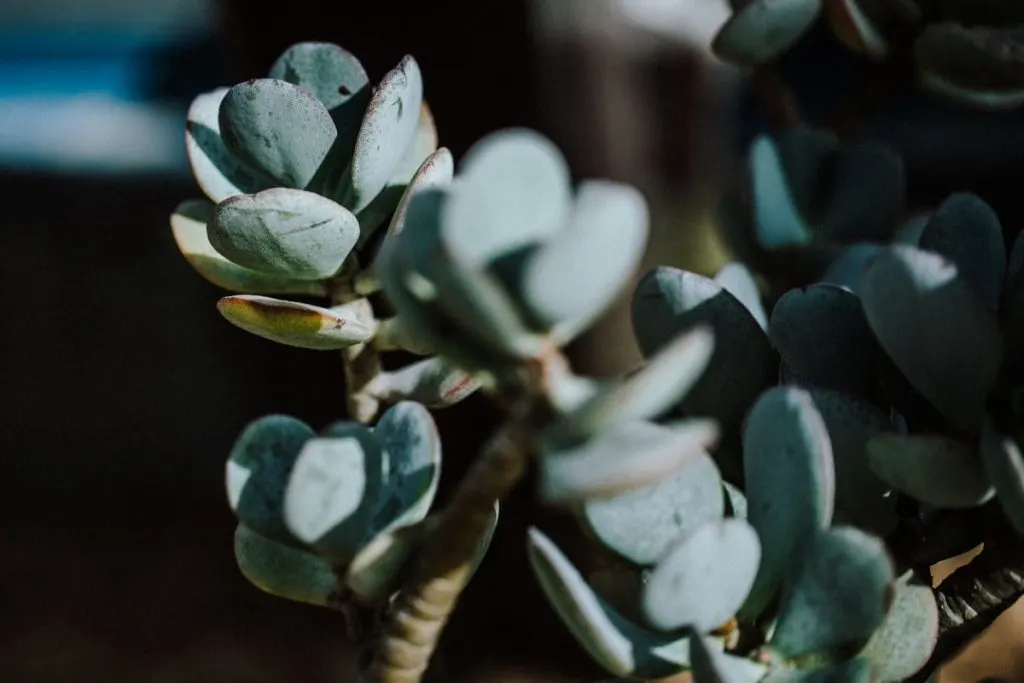
You’ll fall in love with super pale green almost silver leaves of a silver dollar jade. Of all jade types, this one is the easiest one to take care of. It’s native to North America and grows in most such conditions.
LIGHT NEEDS
Expose it to direct sun for 2 hours per day, morning sun is much better since it’s not as strong as the afternoon sun. You can place it on west-facing windows in the afternoon hours.
WATER SCHEDULE
It can tolerate tap water, rainwater, and distilled water. When you plant it first, make the drainage holes right away.
SOIL TYPE
This type of jade plant tolerates almost any soil type: clay soils, black soils, regular potting mix, and cactus mix. Any soil you choose should be slightly acidic.
FERTILIZER
Fertilize it in the springtime with a regular house fertilizer or a liquid fertilizer.
TEMPERATURE AND HUMIDITY
The best temperature ratio for the silver dollar jade plant is between 55 and 65 F. Humidity levels should be from 50 to 60%.
PROPAGATION
Water, stem cuttings, and seedlings propagation are 3 ways to propagate this plant, but the easiest one is stem cutting propagation.
6. Lucky Plant – Crassula Ovata Felix
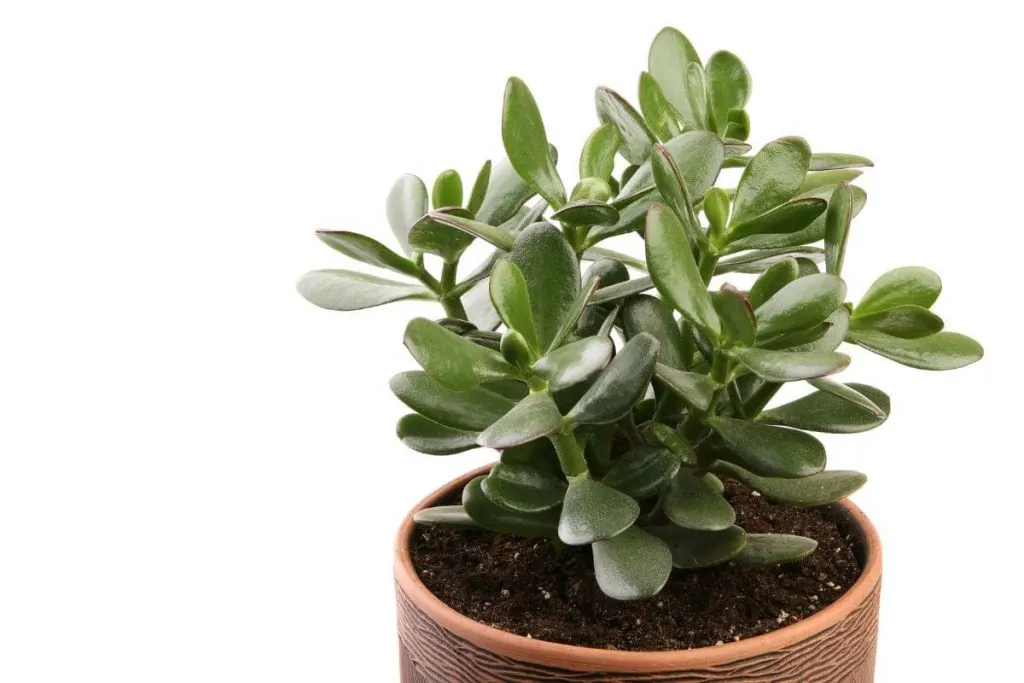
The money plant also known as a lucky plant is a very lovely evergreen green leaves plant. It is similar to the silver jade plant but unlike that one, this plant is supposedly lucky. If you have this plant in your home, money speaking, you should be lucky very soon.
LIGHT NEEDS
Its light needs are very simple. Unlike other jade plants, you can place it in one place only and it can stay there during the entire they. They like bright indirect sunlight. In that case, south-facing windows are the best position for it.
WATER SCHEDULE
Water it twice in 10 days with tap water or distilled water. Rainwater can damage its leaves very easily. It has thick woody stems and that is why you shouldn’t overdo its watering schedule.
SOIL TYPE
Almost any soil type besides sandy soils is suitable for this plant variety. They thrive best in loamy perlite soils.
FERTILIZER
Liquid fertilizers suit them the best, unlike high nitrogen fertilizers that they hate. Avoid them in big circles and always check the contexture of fertilizers before purchasing. Fertilize them in early springtime.
TEMPERATURE AND HUMIDITY
The best temperature ratio for a money tree is between 55 and 75 F. When it comes to its humidity levels, they shouldn’t be above 60%.
PROPAGATION
As Chinese jade plant, ripple jade, and almost any type of jade plant, propagate them with stem cuttings and make sure you use a sharp knife when doing it.
7. Chinese Jade – Crassula Ovata Abidan
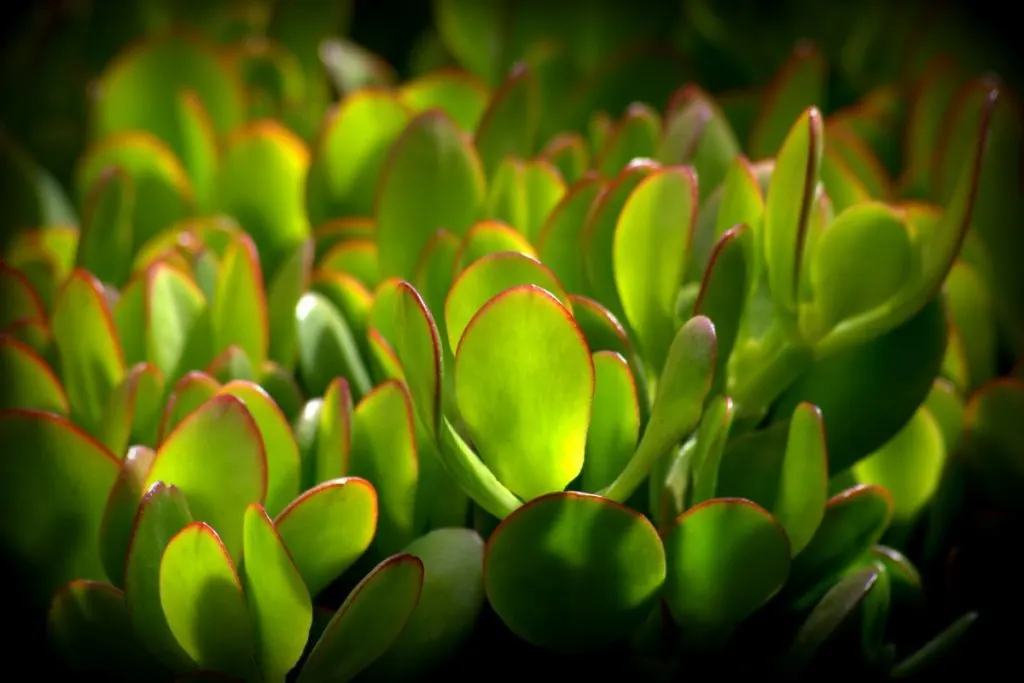
Most people say that a Chinese jade plant is the same as a money plant but there are some differences such as the color of their leaves, intensity of the green color, shape, size, and so on. Those are minor details that you’ll have to check carefully.
LIGHT NEEDS
This jade plant variety and its star-shaped flowers love and prefer bright indirect light in the afternoon hours and lots of morning sun.
WATER SCHEDULE
Water them once a week, with tap water, in the morning hours or in the evening hours. They hate being watered in the afternoon hours when temperatures are higher and when there is much sun.
SOIL TYPE
If you want to improve drainage in your soil, mix perlite soil with regular potting mix and that’s a winning combination of soil for your Chinese jade plant.
FERTILIZER
To achieve its loveliest green color and white flowers fertilize them in springtime with liquid fertilizers or regular hose fertilizer.
TEMPERATURE AND HUMIDITY
The best temperature ratio for these jade plants is between 60 and 75 F. Humidity levels can be from 40 to 60%. The lack of humidity calls for an air humidifier.
PROPAGATION
Propagate these plants in early summer time or late fall time with stem cuttings or from seedlings.
8. Little Jade Tree – Portulacaria Crassula Parvus
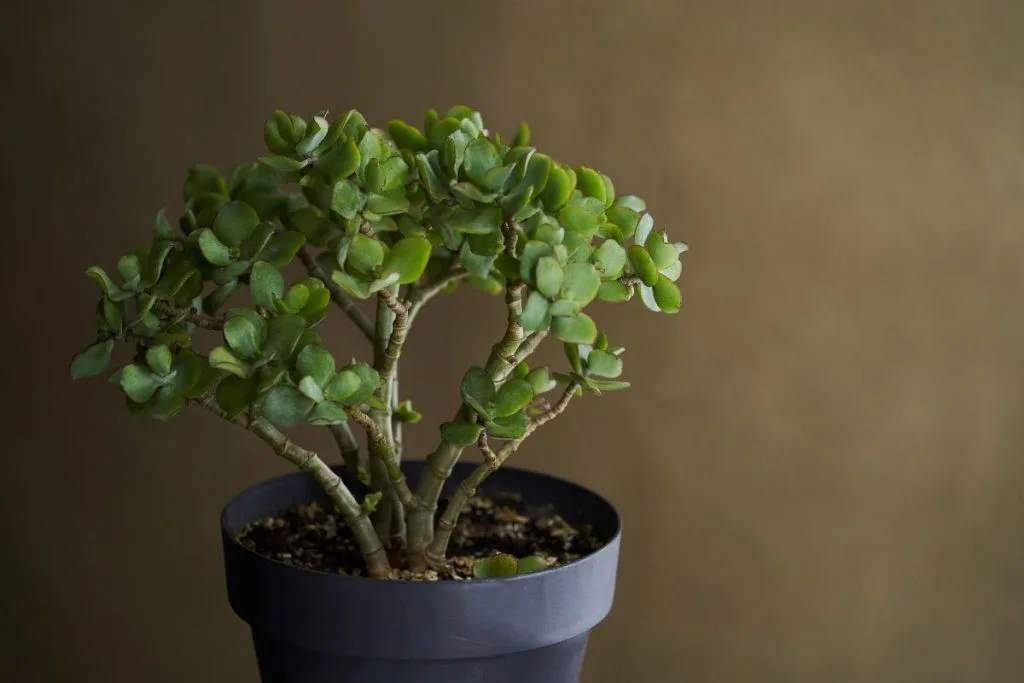
Similar to the dwarf jade tree, this is another small deciduous tree that you’ll completely love and adore. Its green leaves get a golden-yellow color in the fall and they look like a completely different plant. They are very easy to maintain.
LIGHT NEEDS
Expose it to direct sun in the morning for 3 to 4 hours. They don’t like partial shade at all, bright indirect light suits them too. Due to that, north facing window works the best.
WATER SCHEDULE
Water your jade plant in the morning with tap water or in the evening hours when the sun sets. The combination of water and the strong sun is not good for the plant. Avoid standing water in the pot.
SOIL TYPE
Like most types of peperomia, they prefer clay soils, perlite, and peat moss soils. They don’t like soggy soils at all.
FERTILIZER
Fertilize them with a regular house fertilizer that you can use for most of your plants. Avoid liquid fertilizer for this type of jade plant.
TEMPERATURE AND HUMIDITY
The best temperature ratio is between 55 and 70 F. Sudden temperature changes can easily damage your plant. Humidity levels can be from 50 to 60%.
PROPAGATION
Propagate a little jade tree and its hard stems with a sharp garden knife by using a method of stem cuttings.
9. Green Penny Jade – Viridis Assem
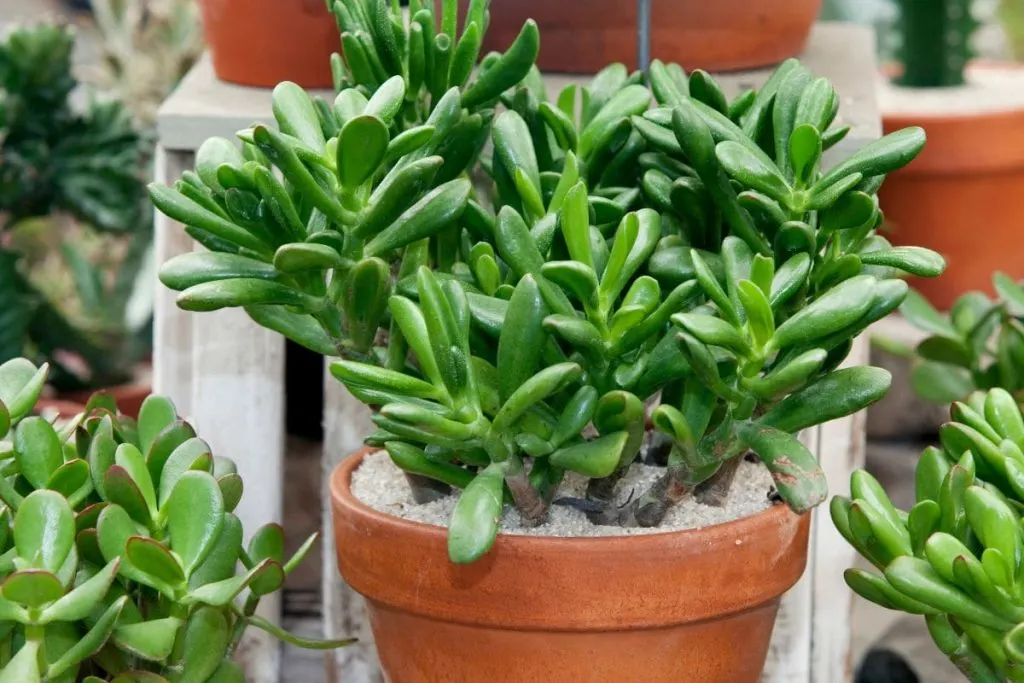
This beautiful type of jade varies in its shades of green. It is more light green in its youth, and as it matures, its leaves become darker green.
LIGHT NEEDS
When we talk about perfect light for this plant, it needs at least 5 hours of daily sun, afternoon or morning, it’s your choice. the best location for this plant is a south-facing window.
WATER SCHEDULE
Water it with distilled or tap water once every 7 days or every 10 days. Before planting, make drainage holes in the pot.
SOIL TYPE
They like almost any soil type, but avoid sandy soils since they have a hard time rooting in such soils. Maybe the peat moss soils are the best choice.
FERTILIZER
Avoid liquid fertilizers, and use only organic fertilizers for this plant. Your best bet is to use compost when it comes to this type of plant.
TEMPERATURE AND HUMIDITY
The best temperature ratio is between 55 and 65 F. Try to specify the temperatures, no more and no less. Humidity levels should be around 60%. This plant grows excellently in the toilet.
PROPAGATION
Take a healthy twig from your jade plant and cut off the one with the best and healthiest leaves. Transplant it in fresh, clay soil that is thoroughly drained and fertilized.
Problems With Jade Plants
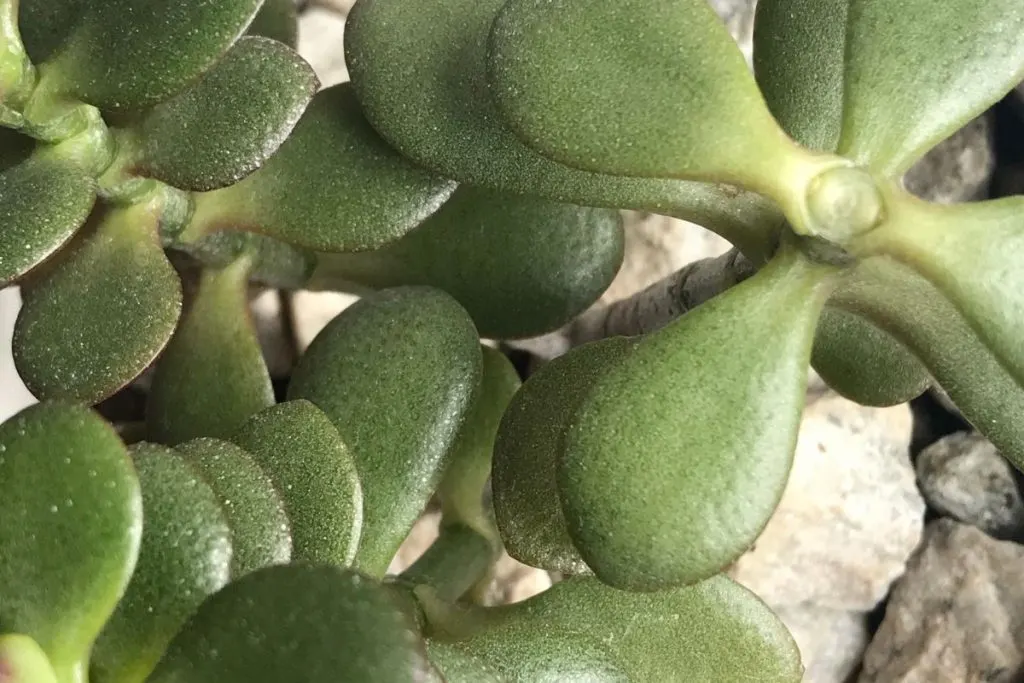
Every house plant eventually encounters a problem, no matter how much care and effort you put into their care. This lovely houseplant may encounter problems such as root rot, yellowing leaves, brown tips of the leaves, and white spots on jade plant.
All of these problems are caused by lack of care or sometimes too much care (excessive water issues). Sometimes, this plant can also look droopy, very similar to the plant of fiddle leaf fig leaves drooping.
Root Rot Problems With Jade Plant
Root rot issues are usually caused by too much water. In that case, you should reduce watering for some time, but to be fair, root rot is already a big problem and your plant might not survive. Make sure you always make drainage holes in your pot.
Yellowing Leaves Issue On Jade Plant
Yellowing leavesare also the problem of too much water and sometimes too much direct sun in the morning hours. What you should do once you notice this problem, is cut off the yellow edges so that the yellowing issue doesn’t spread.
Brown Edges Problem On Jade Plant
Brown edges can be a problem when your plant is facing too much sun and also, a sudden temperature change. If you notice this problem, do the same thing as with the yellowing leaves issue, cut off the damaged edges to avoid the spreading of the browning problem.
FAQ – Types Of Jade Plants
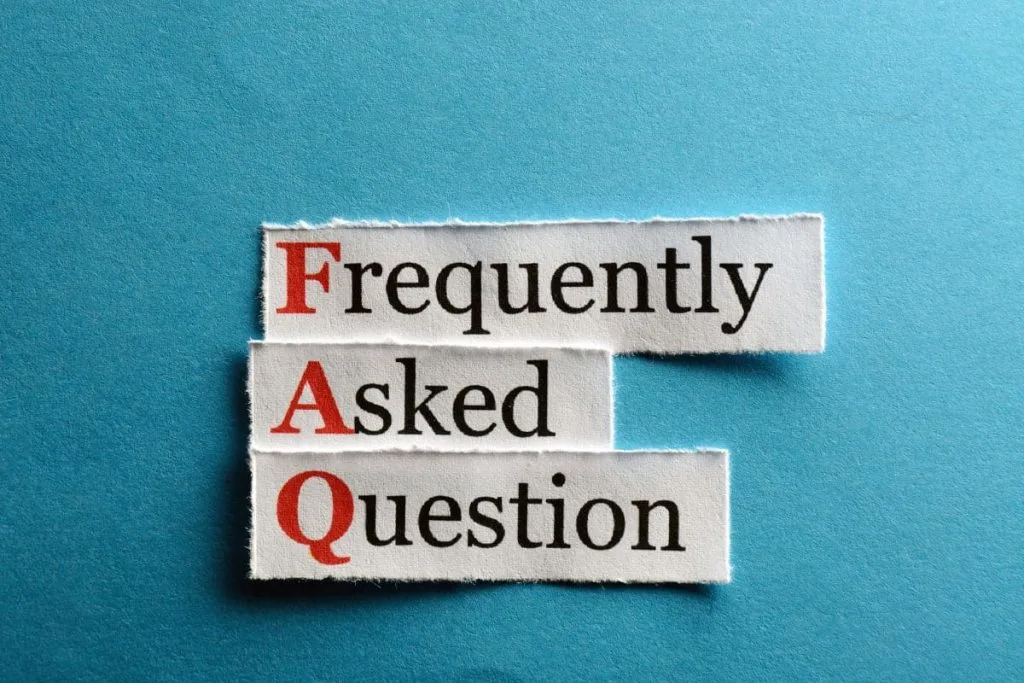
As always, so today, we make sure to answer all the questions you have about some plants, today they are types of jade plants. In that case, we know you have some frequently asked questions about these plants, so let’s answer them.
How Can I Identify That I Have A Jade Plant?
Jade plants are quite specific and easily recognizable. If you received a baby jade plant from someone, and you are not sure that it is actually that plant and that this is its name, look at its leaves.
Jade plants have tiny oval leaves, in the shape of a round tear and oval, and that’s how you’ll know and conclude that it’s a jade plant. Of course, based on its colors and variations, you can define its type even more easily.
Is There A Lucky Jade Plant?
According to some sayings, there is a type of jade plant that is lucky and that is the money plant also known as the money tree. The money tree is also one of the best plants for office with no windows.
It is said that a person who has this plant in their home will soon enough be lucky with their finances or will eventually start earning and getting more money. How awesome is that?
Final Thought On Types Of Jade Plants
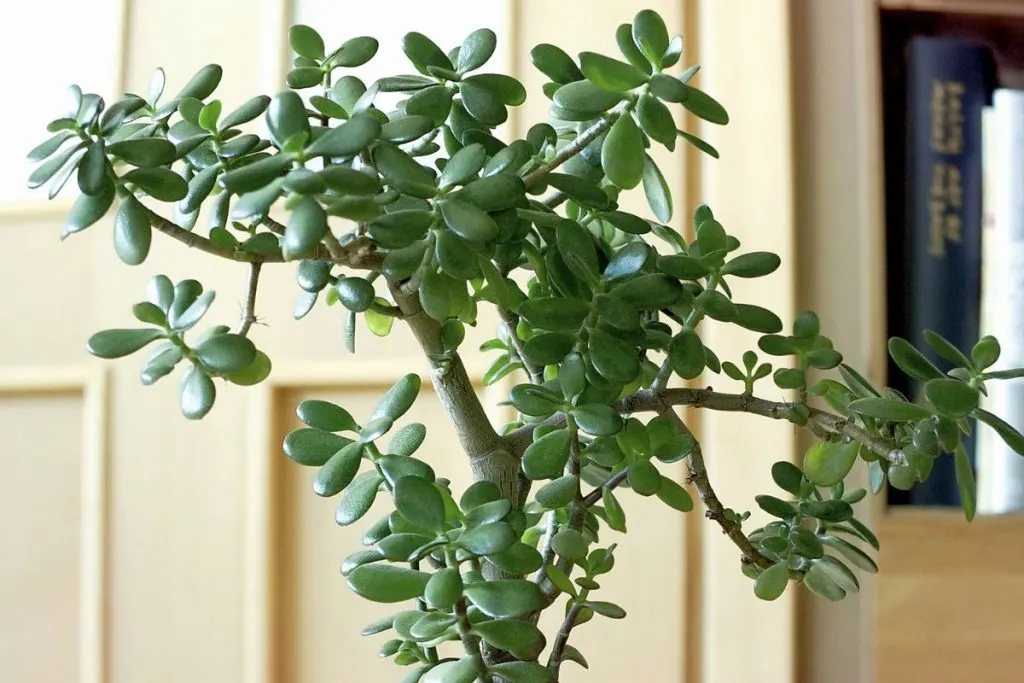
Does it seem to you that you started reading the article 5 minutes ago? When we read about beautiful flowers and plants, time always flies so fast, doesn’t it?
Have you decided on the type that suits you the most? You don’t have to choose your favorite right away, look through the beautiful photos of types of jade plants a few more times and then decide on the right one.
Each one has its own unique care guide, but let’s be realistic, the differences are not huge, and if you learn to take care of one, it’s like you learned how to take care of 90% of jade plants.
We have also listed the most common diseases of this plant in order to avoid problems as soon as possible and prevent them from the start.
That would be all for today, see you soon for more similar topics!

